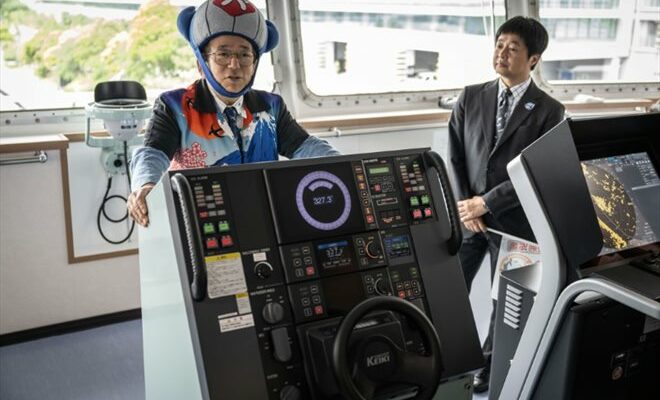The Kangei Maru, Japan’s new factory ship for this fishery banned almost everywhere else in the world, leaves its home port of Shimonoseki (western Japan) on May 21, 2024 (AFP/Yuichi YAMAZAKI)
Apron, shirt and tie with whale motifs, blue hat in the shape of a cetacean, Hideki Tokoro proudly presents the state-of-the-art equipment of the Kangei Maru, Japan’s new factory boat for this fishery banned almost everywhere else in the world.
This ship, almost 100 meters long, which left its home port of Shimonoseki (western Japan) on Tuesday, arrived in Tokyo on Thursday, where several media including AFP were able to visit it.
He is due to leave on Saturday for more than seven months of whaling, off the northeast and northern coasts of the archipelago.
“It is a new ship for a new era, symbolizing the phase of resumption of commercial whaling” in Japan since 2019, Mr. Tokoro, president of the Kyodo Senpaku whaling company, owner and operator of the vessel, said on Tuesday. Kangei Maru.

A member of the crew of the Kangei Maru, Japan’s new factory ship for whaling banned almost everywhere else in the world, shows the 30-centimeter blade with which workers will sort between useful meat and animal waste. Photo taken on board the ship in Tokyo port, during a press visit on May 23, 2024 (AFP/Yuichi YAMAZAKI)
It is a gigantic butchery designed for the high seas, with a covered bridge of around forty meters to cut up the whales, which will be hoisted there once slaughtered by a winch that can tow up to 70 tonnes, on a sloping ramp. gentle.
“Be careful, they are very sharp,” warns Mr. Tokoro of the 30-centimeter blades with which workers will sort between useful meat and animal waste, which will be thrown into the ocean.
Conveyor belts will transport the blocks of meat, which will then be packaged and stored in refrigerated containers with a capacity of 15 tonnes each.
– An uninhibited hunt –
The Kangei Maru is not equipped for capture: a smaller ship alongside it, equipped with a harpoon gun, will take care of this part of the job. But with its drones, the factory boat will contribute to spotting prey.
Among other innovations compared to the Nisshin Maru, its predecessor withdrawn from service last year after 30 years of service, the Kangei Maru also has individual cabins and wifi, to improve the comfort of its approximately 90 crew members. .
Despite the establishment in 1986 of an international moratorium on commercial whaling, Japan persisted in exploiting and misusing an exception clause authorizing missions for scientific purposes.
Also the Nisshin Maru had become the bane of environmental NGOs like Greenpeace and Sea Shepherd, whose activists did not hesitate to harass it as far as Antarctica to disrupt its activities.
Since leaving the international moratorium in 2019, Japan has openly resumed commercial whaling, but now limits it to its own maritime space.
International tensions on the subject have clearly decreased in intensity since then, as have Japan’s catches, which represent a few hundred whales per year (294 in 2023). Its quota for this year is 350 whales.
– Battle of arguments –
Japan is one of the last three countries to hunt these cetaceans, along with Norway and Iceland.

Hideki Tokoro, with a blue cetacean-shaped hat, president of the Kyodo Senpaku company, owner and operator of the Kangei Maru, Japan’s new factory ship for whaling banned almost everywhere else in the world, stands expressed during a press briefing aboard the ship in Tokyo port on May 23, 2024 (AFP/Yuichi YAMAZAKI)
The Japanese government defends this fishing, arguing that it has been an integral part of the country’s culture for centuries and that it is of interest in terms of food security for the archipelago, which is poor in agricultural land.
Mr. Tokoro also puts forward other arguments. As whales are at the top of their ecosystem, they swallow large quantities of sea creatures “that should feed other” living things, including humans: “We catch less and less squid and swordfish in Japan because the number of whales is increasing,” he says.
“So we have to cull some whales to preserve the balance of the ecosystem,” he concludes.
“For decades, Japan has been putting forward fallacious arguments about food security to justify whaling, while even its population refuses this meat,” retorts Patrick Ramage, an expert on the subject at the International Fund for Human Protection. animals (IFAW).
Whale meat consumption has indeed fallen in Japan to around 2,000 tonnes per year today, compared to 200,000 tonnes in the 1960s, as other meats have become much more accessible.
Conservationists also dispute the argument that whales compete with humans for marine resources, emphasizing instead their usefulness for ocean health, biodiversity and the fight against global warming.
© 2024 AFP
Did you like this article ? Share it with your friends using the buttons below.




